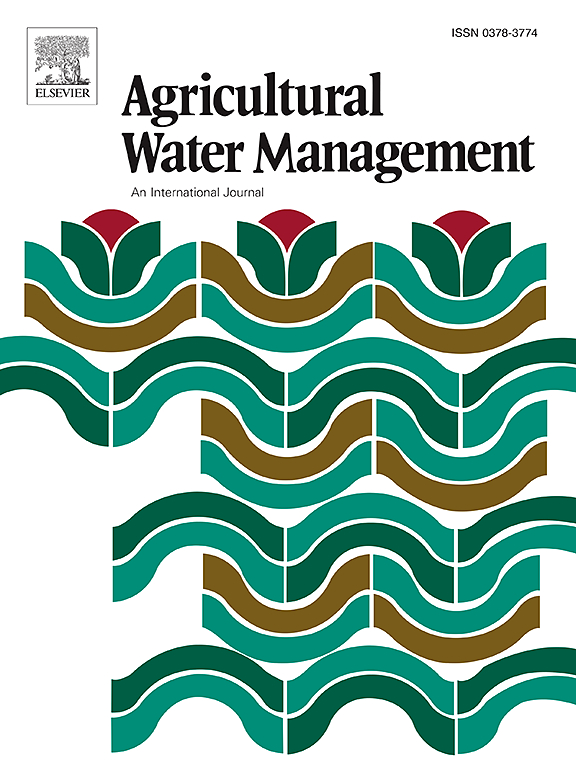涡度协方差、OpenET 集合模型和水与能量平衡模型 (BAITSSS) 之间的柑橘蒸散量相互比较
IF 5.9
1区 农林科学
Q1 AGRONOMY
引用次数: 0
摘要
基于遥感的地表能量平衡算法已被用于估算各种作物的用水量。然而,柑橘的蒸散量(ET)估算具有挑战性,这主要是因为柑橘叶片常绿且树冠结构丛生。在这项研究中,我们评估了两种计算蒸散发的方法的性能:OpenET 模型集合(主要是基于卫星的热模型)和 BAITSSS 水与能量平衡模型。计算得出的蒸散发与(i.)涡度协方差(EC)蒸散发测量数据和(ii.)加利福尼亚州圣华金河谷两个柑橘园的受水(灌溉加降水)数据进行了比较。基于北极星的土壤水力特性和测量的体积含水量分别用于 BAITSSS 参数化和初始化。基于 Sentinel-2 的 NDVI 被用于 BAITSSS 模拟。结果表明,基于 OpenET 集合模型的年蒸散发量(1169 毫米)比 EC 蒸散发量(908 毫米)和实测水分含量(886 毫米)平均大 30%(r2 ∼ 0.71,RMSE ∼ 1.16 毫米)。这种差异主要出现在春季。另一方面,BAITSSS 与观测结果(r2 ∼ 0.77,RMSE ∼ 0.94 毫米)相比,结果参差不齐。在模拟期间的大部分时间里,EC 值和 BAITSSS 及集合 OpenET 的模拟蒸散发值均低于草地参考蒸散发(ETo)。土壤水分和水分接收数据表明果园可能存在灌溉不足。总之,本研究强调了柑橘果园蒸散发模拟所面临的挑战,以及改进这种特殊作物蒸散发估算的必要性。本文章由计算机程序翻译,如有差异,请以英文原文为准。
Intercomparison of citrus evapotranspiration among eddy covariance, OpenET ensemble models, and the Water and Energy Balance Model (BAITSSS)
Remote sensing-based surface energy balance algorithms have been used to estimate water use of various crops. However, citrus evapotranspiration (ET) estimation is challenging mainly due to evergreen leaves and a clumped canopy structure. In this study, we evaluated the performance of two methods for calculating ET: the ensemble of OpenET models, which are mostly satellite thermal-based models, and the BAITSSS water and energy balance model. Calculated ET was compared with (i.) eddy covariance (EC) ET measurements and (ii.) water received (irrigation plus precipitation) data for two citrus orchards in San Joaquin Valley, California. Polaris-based soil hydraulic properties and measured volumetric water content were used for BAITSSS parameterization and initialization, respectively. Sentinel-2 based NDVI was used for BAITSSS simulation. Results showed that annual ET based on the OpenET ensemble model (1169 mm) was on average 30 % larger (r2 ∼ 0.71, RMSE ∼ 1.16 mm) than both EC ET (908 mm) and water received (886 mm). The disparity mostly occurred in spring. BAITSSS, on the other hand, showed mixed results compared to observations (r2 ∼ 0.77, RMSE ∼ 0.94 mm). Both measured from EC and modeled ET from BAITSSS and ensemble OpenET values were below grass reference ET (ETo) for the majority of the simulation period. Soil moisture and water received data indicated the orchards may have been deficit irrigated. Overall, this study highlights the challenges of ET modeling in citrus orchards and the need for improved estimation of ET for this specialty crop.
求助全文
通过发布文献求助,成功后即可免费获取论文全文。
去求助
来源期刊

Agricultural Water Management
农林科学-农艺学
CiteScore
12.10
自引率
14.90%
发文量
648
审稿时长
4.9 months
期刊介绍:
Agricultural Water Management publishes papers of international significance relating to the science, economics, and policy of agricultural water management. In all cases, manuscripts must address implications and provide insight regarding agricultural water management.
 求助内容:
求助内容: 应助结果提醒方式:
应助结果提醒方式:


